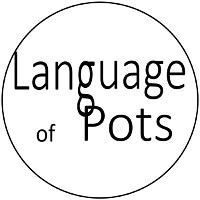
We all know what a pot is. Made of fired clay, pots are containers that we eat and drink out of, aren't they? Well, yes but this narrow perception goes little way to explain the diversity of pots made by people throughout the world where clay is found and for more than 20 000 years.
Language of Pots aims to broaden the conversation around what a pot might be. In an increasingly globalised and connected world pots represent a commonality of human experience and cultural expression. They represent a creative media of personal and cultural identity that is as old as humanity itself.
The objective of Language of Pots is to develop an understanding and way of speaking and writing about pots that treats the artform as three dimensional sculptural creations. The discussion defining pottery by its craft and material of ceramics is limiting. Here we want to concentrate on the visual language of the pot form, to focus on the formal, subjective and metaphoric visual language that is specific to the pot traditions and in so doing broaden the understanding of what a pot might be.
The Anthropology of Art helps contextualise this project. What the Language of Pots is seeking to do is to discuss pottery from the stance of world art, from the understanding of art making in an anthropological sense and not as defined by the Western European canon of art. This canon results in institutional structures like African pots being housed in the British Museum, while the V&A Museum collection is extensively made up of European and Asian pots. Similarly, the huge and diverse traditions of pots from the Americas (pre European settlement) is thinly represented and mainly in the British Museum.
With ceramics becoming fashionable as a material for contemporary artists to work in, it is a good time to raise the discussion and to differentiate between ceramics as a medium and pots as a media. Here the term media is used as in print media or photographic media, where it is a media of communication. A format with its own history and traditions that can be built on. Where the communication between artist and viewer is carried by a visual code or language of form, surface and in the case of pots, sculptural qualities that refers to and references much more than just the medium of the material.
Mention pottery and function immediately comes to mind. The narrowness with which function is considered is an issue that Language of Pots would like to expand on. It is time to go beyond the limiting utilitarian thinking of pottery. Once pots are considered as universal sculptural objects then the question becomes, what is the function of any sculpture? The overriding aim of this project is to broaden the conversation around pottery and in so doing change public preconceptions of what pots are.
Language of Pots would like to hear from anybody who has similar sympathies with regards to the re-contextualising of pots within (cross cultural) artistic creative practice. It is hoped that this project will gain momentum and develop a global network of individuals supportive of thinking about pottery in this manner. The aim is to create a platform that will contribute to shifting how pottery is considered in the arts and that this will stimulate new writing, exhibiting and curation of pots.